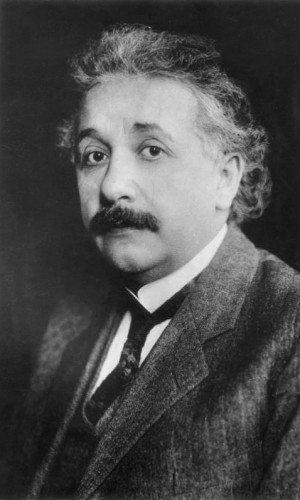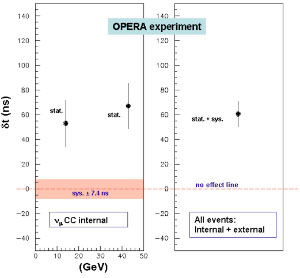Experimental physics plays many roles in advancing science. We make lots of measurements that help enable us to describe the physical world. We test theories and sometimes it leads to surprising discoveries that change our understanding of the physical world. Part of doing and advancing science is experimentally checking the correctness of our description of nature, even if we expect to only validate what is theoretically expected. That is a duty of experimental physics, and every once in a while we are surprised, finding that even long-held beliefs are wrong.
For more than 100 years, we have had very good reason to believe that based on Einstein’s theory of relativity, no particles travel faster than the speed of light. Nevertheless, as physicists we have the responsibility to check such a ‘law’ as precisely as we are experimentally able. An experiment has just performed such a measurement and has presented evidence that neutrinos originating at CERN and detected in the OPERA experiment at Gran Sasso Laboratory travelled faster than the speed of light. Astonishingly, they claim that the arrival time from CERN for neutrino is 60 nanoseconds earlier than expected for particles travelling at the speed of light. Wow! But is this result correct?
In 1976, Frank Sciulli of Columbia University and I were co-spokesmen for a neutrino experiment at Fermilab designed to study high-energy neutrino interactions using a special beam having two bands of neutrinos, one from pion and one from kaon decay. One day, Professor George Kalbfleisch, a physicist at the University of Oklahoma, approached us and suggested that we use our experiment to check the velocity of neutrinos. Intrigued, we joined together to measure the neutrino velocity in 1976; George and collaborators followed up with a higher statistics analysis in 1979. Our technique was to make a straightforward comparison of the arrival times of neutrinos and antineutrinos interacting in our detector with those of high-energy muons that penetrated the shield. The two resulting papers are quoted as reference 5 (Phys. Rev. Lett. 43, 1361 (1979) and Phys. Rev. Lett. 36, 837 (1976)) in the OPERA experiment paper, and they report no measurable deviation from the speed of light with a limit of |v-c|/c < 0.4 x 10-4.

Fermilab setup in 1976 for direct measurement of neutrino velocity by comparing neutrino interactions with high-energy muons penetrating the shield
The long-baseline experiments that have recently been developed to measure neutrino oscillations give us an opportunity to significantly improve these measurements because of the very long path length traversed by the neutrinos (about 732 kilometres in the case of the CERN-to-Gran Sasso beam). However, to exploit this long baseline, new techniques are required to accurately measure the distance from the accelerator to the detector, to determine the start time of the neutrino beam and to determine the interaction time and position of neutrinos interactions in the detector.
The MINOS experiment had already made such a long-baseline measurement for neutrinos, yielding a result for about-3-GeV neutrinos published in 2007. They compared detection times of neutrino events in their near detector at Fermilab near Chicago, US and their far detector at the Soudan mine in Minnesota, coincidentally also some 734 kilometres away. MINOS recorded a total of 473 far-detector neutrino events and used them to measure for neutrinos |v −c|/c = 5.1 ± 2.9 × 10−5 (at 68% confidence level), consistent with the speed of light to within 1.8 σ.
The OPERA experiment at Gran Sasso, like MINOS, was built to study long-baseline neutrino oscillations. Their new measurement of neutrino velocity has much larger statistics and also, they claim, improved systematics. They have made a concerted effort to reduce the systematic errors by improving the timing systems and making accurate measurements of the neutrino baseline through accurate GPS measurements transferred deep underground to the detector. As a result, they find an apparent early arrival for neutrinos relative to that expected for particles moving at the speed of light in vacuum of 60.7 ± 6.9 (statistical), ± 7.4 (systematic) nanoseconds. This early arrival corresponds to an improved measurement of neutrino velocity relative to the speed of light of |v-c|/c = 2.48 ± 0.28 (statistical), ± 0.30 (systematic) x 10-5.
The OPERA result is more precise and therefore not inconsistent with the earlier accelerator limits I discuss above. However, the most sensitive limit comes from neutrinos from a supernova, where the arrival times of neutrinos in the Kamioka detector in Japan and the Irvine-Michigan-Brookhaven detector in the US were compared with photons originating from SN1987a. This analysis yielded a limit of |v − c|/c < 2 × 10−9, four orders of magnitude better than the terrestrial accelerator measurements. There is one caveat, however: The supernova neutrinos are much lower-energy neutrinos (about 30 MeV).
Where does all of this leave us? Can we conclude that neutrinos travel faster than the speed of light?? Of course not! This result must now be followed up by rigourous analysis of their experiment. The OPERA analysis is now undergoing just such scrutiny by the scientific community. Already, valid questions have been posed. One is whether there are corrections due to the motion of the satellite in using GPS. Another is drawn up in a theoretical paper by Cohen and Glashow. The authors show that such superluminal neutrinos would lose energy by radiating electron-positron pairs on the way to the Gran Sasso. They claim the result is therefore not possible and they also point out that it is inconsistent with other experiments.
Finally, the experimental observation must be checked by another experiment, MINOS, which is expected to make a renewed effort to confirm or refute this result. This is one of the real beauties of being a physicist. We can generally check claims like OPERA’s by critiques such as those by Cohen and Glashow and by checking it experimentally.
If this astounding result actually does turn out to be correct, it will change our fundamental understanding of physics. But, before we get too excited, we need to let this play out. Ultimately experiment will decide.
As a final thought, one might wonder why this result so quickly captured the imagination of the public. My colleague Nick Walker relayed to me a conversation he had with his son, Patrick. When the OPERA result hit the news, the 14-year-old asked Nick with curiosity: “Does the neutrino weigh anything?” His dad (Nick) said that it was an interesting question, and in fact by recent experiments we know the answer is YES. Patrick then displayed his joy and replied, “GOOD! That means there is hope for us (to go faster than the speed of light)!”




Before 23 years, I had proved mathematically that relative velocity may be more than light velocity. CERN proved experimentally that velocity of Neutrinos may be more than light, if this news will be confirmed then that will be new beginning of physics.
Please read paper “What is matter & dark matter is made up of?” on my web site. This paper may help to find solution to problems like what is dark matter? & about true relativity. I strongly oppose special theory of relativity